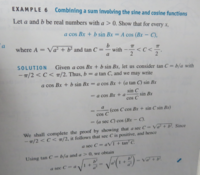allegansveritatem
Full Member
- Joined
- Jan 10, 2018
- Messages
- 962
Here is an example problem that contains an expression I don't get and it is not at all introduced in the text. Here is the example:

My problem with this is I don't see anything about C being a tangent anywhere in the original layout of the equation. Am I supposed to know that a variable in that position is by some definition a tangent? So, whee did the tangent come from. I seem to vaguely recall discovering on my own that the phase shift was a tangent of something...but I don't know if that applies here.

My problem with this is I don't see anything about C being a tangent anywhere in the original layout of the equation. Am I supposed to know that a variable in that position is by some definition a tangent? So, whee did the tangent come from. I seem to vaguely recall discovering on my own that the phase shift was a tangent of something...but I don't know if that applies here.
